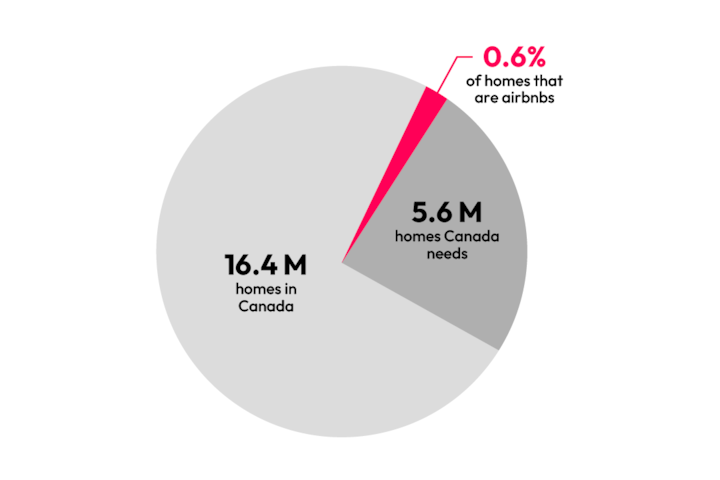The closer you look, the clearer it gets.

Canada is facing a housing crisis, and the demand for action grows daily.
In fact, according to the Canada Mortgage and Housing Corporation, we need 5.8 million additional homes by 2030 to reach affordability. Some have suggested further regulating (and in some cases, converting) short-term rentals such as Airbnbs as a potential solution. But according to Statistics Canada the number of Airbnbs that could be used as long-term homes make up only 0.6% of Canada's housing.Which leaves us with a very important question:How can you solve a crisis with 0.6% of a solution?

By the numbers
5.8 million
homes needed in Canada by 2030 to reach affordablity
Airbnbs make up only 0.6%
of Canada’s housing
77%
of hosts in Canada rent their homes to cover the rising cost of living
55
the median number of nights a host in Canada hosts guests annually
Keeping Canadians in their homes
Experts agree that chronic, decades-long underproduction of new housing is the primary driver of the challenges we face today, not short-term rentals. In fact, 47% of hosts in Canada say income from hosting has helped them stay in their homes.But that doesn’t mean we aren’t committed to partnering with the government to help find solutions. We work with governments to ensure that local rules for short-term rentals preserve the economic benefits of hosting and help people stay in their homes.




More regulations aren’t the answer
Strictly regulating short-term rentals has been ineffective in addressing the housing crisis in the jurisdictions who have done so to date. Further restrictions on short-term rentals will not help the housing crisis in Canada.
“Contrary to the common narratives around Airbnb listings, of the 30 per cent increase in rents observed in our sample of neighbourhoods since 2016, at most less than 1 percentage point can be attributed to increased Airbnb activity.” - Conference Board of Canada“Put simply, restricting Airbnb is not going to be an effective tool for solving the housing-affordability problems.” - Harvard Business Review“The data suggest that STRs are not a pivotal factor on the long-term rental market. I don’t think it follows immediately that stopping a unit from being an STR will mean it’s immediately transferred into being a long-term rental.” - Aled ab Iorwerth, deputy chief economist with the national housing agency, Canada Mortgage and Housing Corp.“If your goal is to reduce short-term rentals so that rental prices across the market come down, it’s not going to happen.” - Times Colonist“A ban on Airbnb may sound good to local residents who see it as opening up more housing for them. The truth is, all these restrictions ultimately make residents worse off. – Bloomberg

Airbnb grows local Canadian economies
Airbnb hosts are supporting the tourism sector and helping to grow the economies of towns and cities across the country. In fact, Airbnb generated more than $10B in estimated economic impact across Canada in 2023, supporting local businesses and workers from coast-to-coast-to-coast – often in communities without hotels.
- Guests on Airbnb in Canada generated an estimated $10.4B1 in visitor spending.
- Guest spending generated more than $7.6B in taxes for governments across the country.
- For every $100 spent on an Airbnb stay, guests spent about $283 on other goods and services, such as local businesses, restaurants, attractions, shops and more.
- Travel on Airbnb helped support nearly 110,000 Canadian jobs last year, generating an estimated income of $6.2 billion.

But we want to do more
The only solution to this crisis is to build more supply, and we applaud the work that governments are doing to build more homes. From identifying initiatives where we can make a positive difference, to supporting smart and reasonable short-term rental policies, Airbnb is committed to advocating for solutions that meaningfully help Canada’s housing crisis.
1. Estimated economic impact data is based on an internal analysis using the IMPLAN economic impact model which assesses direct, indirect and induced economic activity.